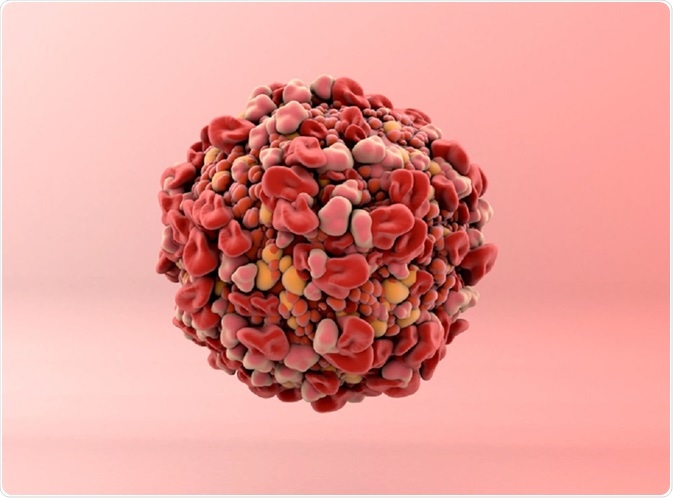Cancer is defined as a group of diseases that have a wide range of causes. Each cancer differs in biology and pathophysiology, but all animals and even plants are susceptible to cancer.
 Design_cells | Shutterstock
Design_cells | Shutterstock
Cancer at the molecular level
The body is made up of trillions of living cells. These cells grow, divide, and die in a process that is tightly regulated and controlled by the DNA machinery within the cell. During development, normal cells rapidly divide to allow for growth. This is in contrast to adulthood, where most cells divide only to replace worn-out or dying cells or to repair injuries.
When cells of the body at a particular site start to grow out of control, they may become cancerous. Cancer cell growth is different from normal cell growth. Instead of dying, cancer cells continue to grow and form new, abnormal cells. In addition, these cells can also invade other tissues. This is a property that normal cells do not possess.
Cancer cells originate from normal cells when their DNA (deoxyribonucleic acid) or blue prints within the cell nucleus is damaged. DNA is in every cell and it directs all the cell’s actions, growth, death, protein synthesis etc. when DNA is damaged in a normal cell the cell either repairs the damage or the cell dies.
Normally, the body safeguards against cancer via numerous methods, such as: apoptosis or a process by which abnormal cells die on their own accord, helper molecules (some DNA polymerases), possibly senescence or aging, etc.
In cancer cells, the damaged DNA is not repaired, and the cell does not die. Instead it gives rise to more such abnormal cells with abnormal DNA. These new cells all have the same defective DNA of the original cancer cell.
DNA damage may be inherited from parents or may be a spontaneous problem that occurs during the lifetime of a person. This is called a mutation. DNA damage may also be triggered by exposure to certain environmental toxins such as those present in cigarette smoke. There are, however, multiple factors that may cause cancer and it is difficult to pin point an exact cause.
How do cancer cells behave differently from healthy ones? - George Zaidan
What are mutations?
Mutations are any changes to the DNA of a cell. There are many types of mutations, and these include:
- Those in the error-correcting machinery of a cell. This may cause accumulation of errors rapidly in the cell and its progeny.
- Those in signaling (endocrine) machinery of the cell. This leads transmission of the error signals to nearby healthy cells as well.
- Those that allow the cells to migrate and disrupt more healthy cells away from the primary site of origin.
- Those that make the cell immortal so that the abnormal cell refuses to die.
Risk factors for cancer
According to World Health Organization (WHO), common risk factors for cancer include:
- Tobacco use
- Alcohol use
- Overweight and obesity
- Dietary factors, including insufficient fruit and vegetable intake
- Physical inactivity
- Chronic infections from helicobacter pylori, hepatitis B virus (HBV), hepatitis C virus (HCV) and some types of human papilloma virus (HPV)
- Environmental and occupational risks including ionizing and non-ionizing radiation
Cancer-causing agents
Agents that may cause cancer include:
Chemical carcinogens
Several chemicals and environmental toxins are responsible for changes in normal cellular DNA. Substances that cause DNA mutations are known as mutagens, and mutagens that cause cancers are known as carcinogens.
Particular substances have been linked to specific types of cancer. Tobacco smoking is associated with many forms of cancer, and causes 90% of lung cancer. Similarly, prolonged exposure to asbestos fibers is associated with mesothelioma.
Tobacco is also related to other cancers such as lung, larynx, head, neck, stomach, bladder, kidney, oesophagus and pancreas as it contains other known carcinogens, including nitrosamines and polycyclic aromatic hydrocarbons.
Ionizing radiation
Radiation caused by radon gas and prolonged exposure to ultraviolet radiation from the sun can lead to melanoma and other skin malignancies. Radiation therapy given for one type of cancer may also cause another type of cancer. For example, those who receive chest radiation therapy for lymphomas may later develop breast cancer.
Viral and bacterial infection
Some cancers can be caused by infections with pathogens. Notable among these include liver cancers due to Hepatitic B and C infections; cervical cancer due to infections with Human Papilloma virus (HPV); Epstein Barr virus causing Burkitt’s lymphoma and gastric or stomach cancer due to Helicobacter pylori infection.
Genetic or inherited cancers
Common examples are inherited breast cancer and ovarian cancer genes including BRCA1 and 2. Li-Fraumeni syndrome includes defects in the p53 gene that leads to bone cancers, breast cancers, soft tissue sarcomas, brain cancers etc. Those with Down’s syndrome are known to develop malignancies such as leukemia and testicular cancer.
Hormonal changes
There are many hormones in the body, but one of the most notable among these are changes in levels of the female hormone estrogen, which has been linked to uterine cancer.
Cancers of the immune system
Impaired immunity including HIV infection leads to several cancers including Kaposi's sarcoma, non-Hodgkin's lymphoma, and HPV-associated malignancies such as anal cancer and cervical cancer.
Further Reading
Last Updated: Jul 5, 2023